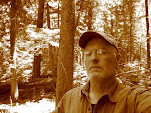Unable to reconcile the nature of Union Bay and the industry of Lake Union, which for your information are separated by one mile of water, I split today's journal into two parts.

I put in on the big lake and decide to make this 1850 day. Settlers arrived here, permanently, during that decade. It is in the mid 30's with not one cloud anywhere and with a light cold wind out of the north. There is a small chop on the lake so that the surface is a dark blue green with black static running through it. Mt. Baker is clearly visible, snow and glaciers all white, on the north horizon, eighty miles away. There are buffleheads and canada geese along the shore, a cormorant or two, and four common mergansers. The common mergansers, a very large and pretty duck, have just arrived recently in the lake (this year). The 1850 skyline is about 100 feet higher, Douglas Firs, Western Red Cedars, maples, and alders replacing the rooftops. The lake is 10 feet deeper and it drains by a river 10 miles south, a river that no longer exists. It is steep where I put in, so that shoreline hasn't changed much, but in many places, where there are now houses, there is instead a quarter mile of shallow water and marsh. The Duwamish live all up and down this and other nearby lakes and along the rivers. Smoke, on a cold day like this, would be the most obvious marker of their village locations. At the opening to Union Bay, a potlatch house stands on the south shore while the point forming the north side is a tangle of forest. Exposed to winds during storms, there would be some massive trees lying on the ground there making land passage difficult. This bay is considered a rather well-to-do village site. In the NE corner of the bay is a longhouse, 2 more are a mile north from the current north shore, that mile being open water and marsh. Another stands near the smokestack that marks the University steam plant. The south shore is a good 1/4 mile south of its current location, and the largest island, the burial island, is the only island in the bay and it is much smaller than it is today. The Duwamish place their dead in boxes and place the boxes in trees on this island. Since then, it has been misused by the settlers and their descendents. This would be fine weather for hunting waterfowl, which would be present in much larger numbers than it is today.
I stop and talk with two bird watching friends on the north shore. The eagles are not out right now, but there are two red-tailed hawks. I am informed that one of them has learned to hunt coots and ducks like the eagles do. One catches a mouse while we watch. The eagles show up as we stand, but they do not go to hunting directly. As I paddle down the west islands, both eagles land on a drift log 30 yards away. They have a dead seagull there. One picks at it, but I get the idea that they would prefer coot and the gull is considered leftovers. I continue on through the cut, which can't be done in 1850, because the cut won't exist until 1916. Instead, there is a well used and ancient portage of maybe 200 yards that takes one into Portage Bay. I continue on into Lake Union, a far too nice day to be inside.
 I made a wrong turn on my portage to the lake,
I made a wrong turn on my portage to the lake,












